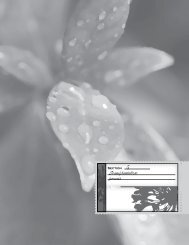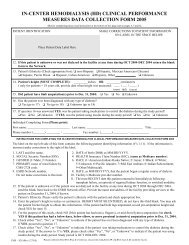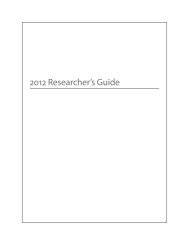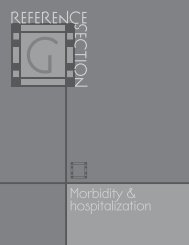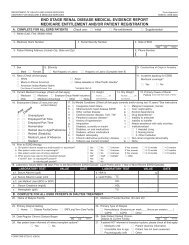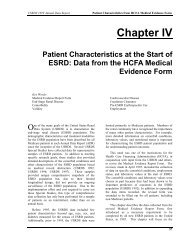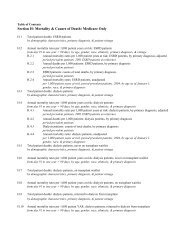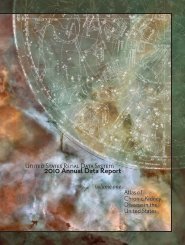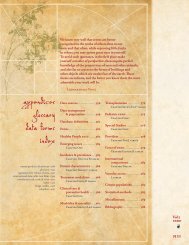Download - United States Renal Data System
Download - United States Renal Data System
Download - United States Renal Data System
You also want an ePaper? Increase the reach of your titles
YUMPU automatically turns print PDFs into web optimized ePapers that Google loves.
computer with access to SAS.<br />
♦ CD-ROM drive: any PC with a CD-ROM drive should<br />
be able to read the SAF CDs.<br />
♦ Disk storage: between 10 and 600 megabytes are needed<br />
to use the Core CD, depending on the files being used.<br />
The data on each CD require from 550 to 650 megabytes<br />
of disk storage. Additional space is needed for<br />
temporary work files and for files users create.<br />
♦ Software: SAS. Files converted to SAS transport format<br />
can be used by SPSS.<br />
♦ People with SAS experience: The SAF documentation<br />
provides basic information about loading the files into<br />
SAS and using them, but further work with the files<br />
requires SAS experience.<br />
File media and formats<br />
The SAFs are provided on CD-ROM disks as SAS files, and<br />
can be used directly by SAS on any 486 or Pentium PC with<br />
a CD-ROM reader.<br />
The SAS format was chosen for the USRDS SAFs because it<br />
is widely used, easily transported, and largely self-documenting.<br />
SAS is a commercially available data management and<br />
statistical analysis software system that runs on most computers,<br />
from mainframes to PCs, and it is almost universally<br />
available on university computer systems. The USRDS SAFs<br />
take full advantage of the program’s ability to incorporate a<br />
large amount of documentation into the file.<br />
Researchers who require a different program format or a<br />
medium other than CD-ROM must arrange for the conversion<br />
themselves. The USRDS may be able to convert files<br />
to alternative formats or media, but at substantially greater<br />
cost.<br />
Cost<br />
The price of the files covers the cost of reproducing and shipping<br />
the file and its documentation, administrative costs of<br />
handling the sales, and costs of technical support for researchers.<br />
Checks must be made payable to the Minneapolis Medical<br />
Research Foundation. Prices are subject to change.<br />
Documentation<br />
This Researcher’s Guide provides most of the documentation<br />
for the SAFs by including a codebook of variables in the files<br />
and a chapter on techniques for using the SAFs in SAS (Getting<br />
Started, page 7). The Researcher’s Guide is available in<br />
PDF format at www.USRDS. org.<br />
Acknowledgement for Use of USRDS <strong>Data</strong><br />
Publications that use USRDS data should include an acknowledgment<br />
and the following notice:<br />
The data reported here have been supplied by the <strong>United</strong><br />
<strong>States</strong> <strong>Renal</strong> <strong>Data</strong> <strong>System</strong> (USRDS). The interpretation and<br />
reporting of these data are the responsibility of the author(s)<br />
and in no way should be seen as an official policy or interpretation<br />
of the U.S. government.<br />
<strong>Data</strong> Release Policies and Procedures<br />
Because the SAFs and custom data files contain confidential,<br />
patient-specific data, release of these files requires the approval<br />
process described here. Investigators may contact the<br />
USRDS Project Officer at the NIDDK to discuss their requests<br />
before preparing a written proposal. To request and use<br />
USRDS data files, investigators should do the following:<br />
♦ Provide the USRDS Project Officer with a detailed<br />
description of the proposed investigation (outlined in<br />
Table A.4). The project summary must include goals,<br />
background data, an in-depth description of the study<br />
design and analytic methodology, and resources available<br />
for completing the project. It may be the project<br />
description from a grant or other funding application.<br />
The proposed project must comply with the Privacy<br />
Act of 1974, and the project summary should provide<br />
enough information to enable assessment of compliance.<br />
Guidelines for adherence to the Privacy Act appear<br />
in the USRDS “Agreement for Release of <strong>Data</strong>,” page 44.<br />
♦ Indicate which USRDS SAFs will be needed. If the<br />
USRDS SAFs cannot meet the requirements of the<br />
proposed research, the proposal must specify precisely<br />
which data elements are needed, and investigators must<br />
budget for a substantially higher cost.<br />
♦ If the project is approved, return a signed copy of the<br />
USRDS “Agreement for Release of <strong>Data</strong>” to the Project<br />
Officer. The investigator and the Coordinating Center<br />
will resolve any technical questions and arrange for<br />
payment. Payment must be received before the files will<br />
be released. Checks must be payable to the Minneapolis<br />
Medical Research Foundation.<br />
The NIH will review the project for technical merit and<br />
conformity with the Privacy Act. The Project Officer will<br />
notify the investigator(s) in writing of the outcome, and<br />
if the project is not approved will discuss reasons for the<br />
decision. The Project Officer will send the approval letter to<br />
the Coordinating Center. The process of reviewing the data<br />
request, generating the data file, and releasing the data takes<br />
the Coordinating Center about three months.<br />
When the signed “Agreement for Release of <strong>Data</strong>” and<br />
payment for the files have been received by the Coordinating<br />
Center, the files and documentation will be prepared and sent<br />
to the investigator.<br />
Any reports or articles resulting from use of the USRDS<br />
data must be submitted to the Project Officer before submission<br />
for publication to assure adherence to the Privacy Act.<br />
The Project Officer must respond within 30 days. If a report<br />
or article is determined not to adhere to the Privacy Act, it will<br />
not be published until compliance with the Act is achieved.<br />
Assessment of compliance will not depend on the opinions<br />
and conclusions expressed by the investigators, nor will the<br />
Project Officer’s approval indicate government endorsement<br />
of the investigator’s opinions and conclusions.<br />
All publications using the released data must contain the<br />
standard acknowledgement and disclaimer presented above.<br />
The investigator is requested to send copies of all final publications<br />
resulting from this research to the Project Officer<br />
and to the USRDS Coordinating Center.<br />
42 e Appendix A USRDS Products and Services



